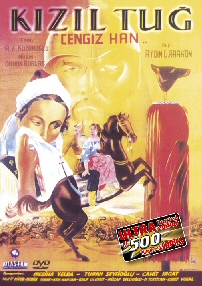
(A.k.a. THE RED PLUME; RED PLUME - GENGHIS KHAN)
Three warriors - Genghis Khan, Kassar Alp and Gelmen the Lion Slayer - wander idly in the countryside one sunny afternoon, stumbling across a tramp that they stop to laugh at. The tramp faces up to the trio announcing himself as Otsukarci (Turan Seyfioglu, THE INVISIBLE MAN IN ISTANBUL), and challenges the mocking Gelmen to a duel.
They draw swords and begin to fight, but the duel is interrupted when a group of Khan's rivals arrive. Otsukarci agrees to help Khan and co fight off the rivals, saying he and Gelmen can finish their business with each other afterwards.
But once Khan and co have fought off the rival gang - after much badly choreographed swordplay and melodramatic orchestral music - the warriors show a newfound respect for Otsukarci's fighting skills and bravery. Khan invites him to come and work for him, offering him fame and riches. But Otsukarci has other plans - he tells them he wants to travel.
Khan asks if Otsukarci's travels will take him past the village of Horasan. When the answer is affirmative, Khan asks if Otsukarci will do him a favour: visit Alamut Castle there, and tell sheikh Seyhyul Gebel to pay the money he owes Khan.
Otsukarci agrees to deliver the message and sets off on his travels.
Next we meet the young Halit chilling out at the Castle, enjoying a harem of attractive women along with a spot of traditional dancing and poetry (!). His fun is cut short when his father, Gebel, request his presence in his royal chambers. Gebel demands to see Halit's fencing skills, as he has arranged for his son to take part in a duel the following day.
When it transpires that Halit is a useless swordsman, Gebel instructs his guards to imprison him.
Then along comes Otsukarci to see Gebel. He has a simple enough task to perform, simply delivering a message. But it all goes tits-up when he gets face-to-face with Gebel and is mistaken for Halit, whom he bears an uncanny resemblance towards.
Fleeing the sheikh's guards, and falling in love with his daughter Sabiha (who oddly enough fancies him, her brother's doppelganger, too), Otsukarci gets himself into all kinds of mischief when he agrees to take Halit's place in the following day's duel …
Cracking along at a zany pace, KIZIL TUG is not easy to follow. The plot is pure hokum anyway: this exists purely as 75 minutes of daft, energetic and cheap fun.
The fight scenes are genuinely entertaining in their badness, while the music is distractingly ill-fitting and the performances universally risible. But that's the appeal of these no-frills Turkish pictures.
Boasting ugly photography and choppy editing, there's no denying KIZIL TUG is a bad film in every technical aspect. But it's entertaining if you approach it with the right frame of mind (drunk, perhaps).
Perhaps, for a Turkish film from 1952, there have been some liberties taken in the English subtitling … does Otsukarci really call Gebel an "old fart", for example?! Elsewhere the dialogue is hilariously matter-of-fact ("I will fight you in a minute but first we must fight someone else" - that sort of thing).
The only slightly contemporary aspect of this relic is the violence which occasionally - with stabbings - feels more like it was filmed in the 60s.
Onar's presentation of the film is, by their own admission, not that great. The film is presented in its original full-frame aspect ratio and to my knowledge is uncut. The image quality is soft, grainy and at times plagued by an incredible amount of specks. Lines run across the screen vertically and horizontally, and the picture jumps several times throughout. But this film is an incredibly rare one from over 50 years ago - it's amazing we're getting to see it at all.
The Turkish 2.0 audio is unfortunately no better. In fact, it's terrible. Although most of the dialogue is loud and clear, there is a large background hiss evident throughout. Occasional dropouts are distracting, and there are a few scenes where dialogue wobbles badly. Optional subtitles are available in Greek and English.
An animated scene-selection menu allows access to the film via 8 chapters.
Extras begin with a reasonably interesting video documentary entitled "Turkish Fantastic Cinema Part 1". Running for 14 minutes, this includes interviews with Turkish film historians intercut with welcome clips from rare early films. Again, this is presented in Turkish 2.0 with optional Greek and English subtitles.
Biographies and filmographies are available in English text for co-stars Atif Kapfan and Seyfioglu.
There's a disappointingly brief photo gallery of only 7 stills.
Finally, a nice touch is a colourful 40-page booklet serving as a catalogue of practically all the Turkish films you'd ever need to know about. There are some great reproductions of original cinema poster artwork in here.
The disc is one of only 500 being produced, and each one is individually numbered.
Not the best that Turkish cinema has to offer then, and certainly not one of Onar's strongest releases. But for those who can tolerate the poor audio and video presentation (which is due to the limited source material, and NOT Onar's mastering, incidentally), you may find something to entertain herein.
Review by Stuart Willis
| Released by Onar Films |
| Region All - PAL |
| Not Rated |
| Extras : |
| see main review |